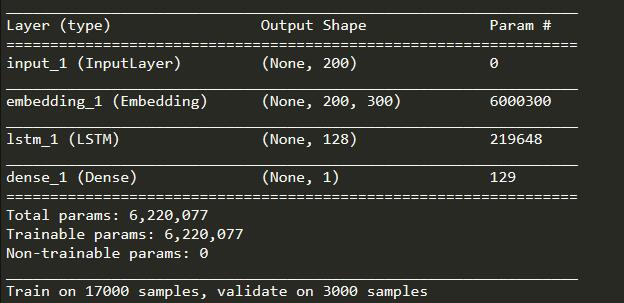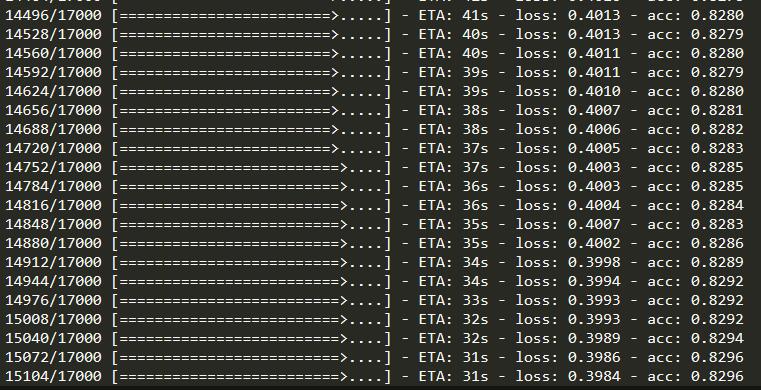数据准备:IMDb电影评论数据集+谷歌的Word2vec模型,(网上找不到的可以私聊我)
完整代码:
import os
import time
import copy
import gensim
import keras
import numpy as np
from sklearn.model_selection import train_test_split
from keras.preprocessing.text import text_to_word_sequence,one_hot,Tokenizer
from keras.preprocessing.sequence import pad_sequences
from keras.models import Sequential,Model
from keras.layers import Input,Dense,GRU,LSTM,Activation,Dropout,Embedding
from keras.layers import Multiply,Concatenate,Dot
#*************************1.读数据,获得X,Y*************************
datapath = r'./data/train'
pos_files = os.listdir(datapath + './pos')
neg_files = os.listdir(datapath + './neg')
pos_all = []
neg_all = []
for pf,nf in zip(pos_files,neg_files):
with open(datapath + '/pos' + '/' + pf,encoding = 'utf-8') as f:
s = f.read()
pos_all.append(s)
with open(datapath + '/neg' + '/' + nf,encoding = 'utf-8') as f:
s = f.read()
neg_all.append(s)
X_orig = np.array(pos_all + neg_all)
Y_orig = np.array([1 for _ in range(12500)] + [0 for _ in range(12500)]) #1表示pos,0表示neg
#*************************2.文本数值化*************************
#设置词典大小为20000,文本序列最大长度为200
#统计词频,过滤掉没有代表性的低频词
#生成词向量
#直接把词向量输入给模型,无法进行继续调优(fine-tune)
#应该加载词向量的同时,继续进行fine-tune
vocab_size = 20000
maxlen = 200
print("Start fitting the corpus......")
t = Tokenizer(vocab_size)
ti = time.time()
t.fit_on_texts(X_orig) #输入x,训练语料库得到统计信息
to = time.time()
word_index = t.word_index #不受vocab_size的影响
print('all_vocab_size',len(word_index))
print('Fitting time:',(to - ti),'s')
print("Start vectorizing the sentences......")
v_X = t.texts_to_sequences(X_orig)
print("Start padding......")
pad_X = pad_sequences(v_X,maxlen = maxlen,padding = 'post')
print("Finished")
#*************************3.筛掉低频词,形成高频词字典*************************
x = list(t.word_counts.items())
s = sorted(x,key = lambda p:p[1],reverse = True) #按词频排序
small_word_index = copy.deepcopy(word_index) #防止原来的字典也被改变了
print("Removing less freq words from word_index dict......")
for item in s[20000:]:
small_word_index.pop(item[0])
print("Finished")
print(len(small_word_index))
print(len(word_index))
#*************************4.词向量的导入*************************
#导入GoogleNews预训练好的300维word2vec词向量
model_file = './word2vec_model/GoogleNews-vectors-negative300.bin'
print("Loading word2vec model......")
w2v_model = gensim.models.KeyedVectors.load_word2vec_format(model_file,binary = True,limit=10000) #不加limit会报Memory error
#把词向量,于word_index结合,构建一个embedding matrix
"""
先随机初始化一个embedding matrix,这里需要注意的是,我们的词汇量vocab_size虽然是20000,
但是训练的时候还是会碰到不少词不在词汇表里,也在词向量也查不到,那这些词怎么处理呢?
我们就需要单独给这些未知词(UNK)一个index,在keras的文本预处理中,会默认保留index=0给这些未知词。
"""
embedding_matrix = np.random.uniform(size = (vocab_size + 1,300))
#(vocab_size + 1) * 300
#vocab_size + 1:+1是要留一个给index = 0
#300:300维的词向量
print("Transfering to the embedding matrix......")
#sorted_small_index = sorted(list(small_word_index.items()),key = lambda x:x[1])
for word,index in small_word_index.items():
try:
#词向量与单词索引之间的映射
word_vector = w2v_model[word]
embedding_matrix[index] = word_vector
except:
print("Word: [",word,"] not in word2vec_model ! Use random embedding instead.")
print("Finished")
print("Embedding matrix shape: \n",embedding_matrix.shape)
#*************************5.划分训练集和测试集*************************
np.random.seed = 1
random_indexs = np.random.permutation(len(pad_X))
X = pad_X[random_indexs]
Y = Y_orig[random_indexs]
X_train,X_test,y_train,y_test = train_test_split(X,Y,test_size = 0.2)
#*************************6.模型搭建*************************
inputs = Input(shape = (maxlen,))
use_pretrained_w2v = True
if use_pretrained_w2v:
w2v = Embedding(vocab_size + 1,300,input_length = maxlen,weights = [embedding_matrix])(inputs)
else:
w2v = Embedding(vocab_size + 1,300,input_length = maxlen)(inputs)
h = LSTM(128)(w2v)
y = Dense(1,activation = 'sigmoid')(h)
m = Model(input = inputs,output = y)
m.summary()
m.compile(optimizer = 'adam',loss = 'binary_crossentropy',metrics = ['accuracy'])
m.fit(X_train,y_train,batch_size = 32,epochs = 3,validation_split = 0.15)
运行效果:
环境参数: Keras 2.1.2 + Tensorflow 1.4.1
参考教程: https://zhuanlan.zhihu.com/p/63852350
点击查看更多内容
为 TA 点赞
评论
共同学习,写下你的评论
评论加载中...
作者其他优质文章
正在加载中
感谢您的支持,我会继续努力的~
扫码打赏,你说多少就多少
赞赏金额会直接到老师账户
支付方式
打开微信扫一扫,即可进行扫码打赏哦







